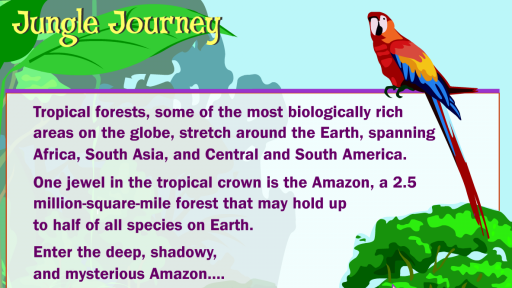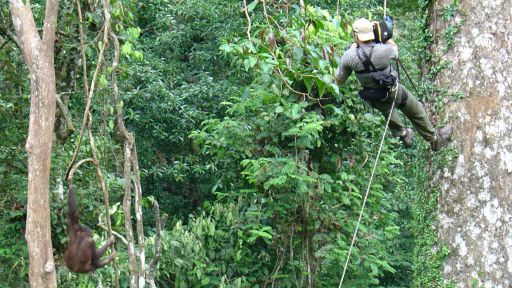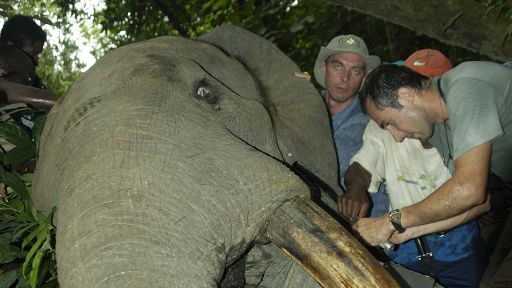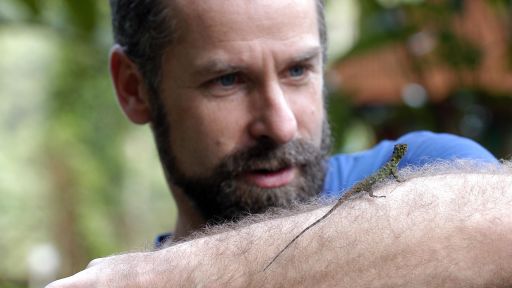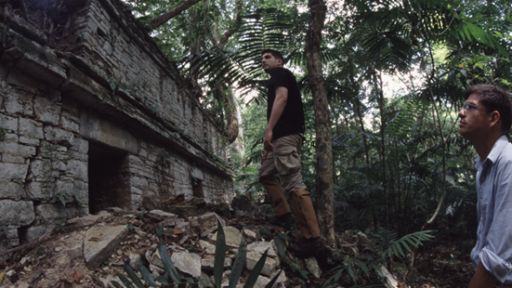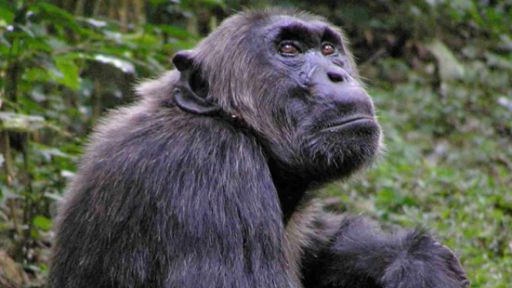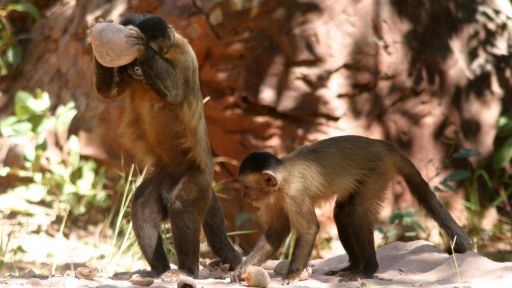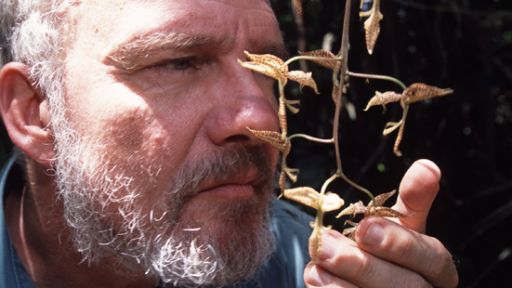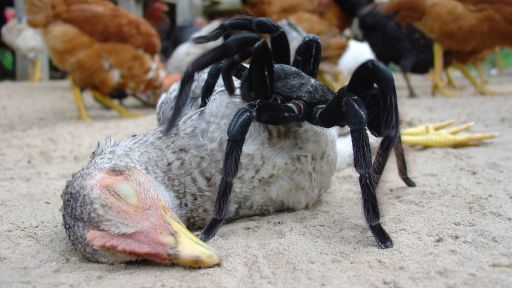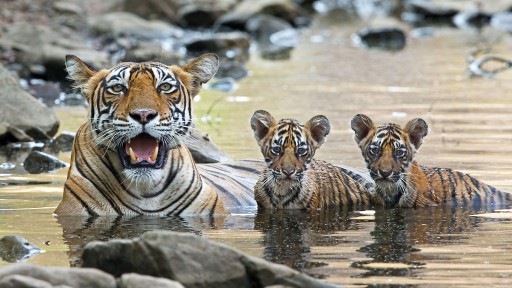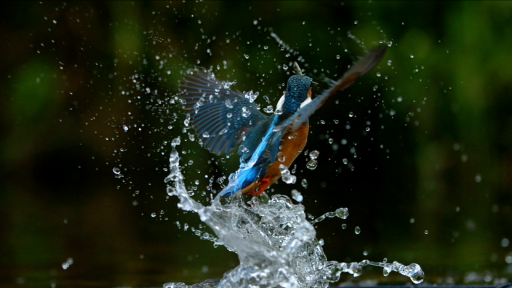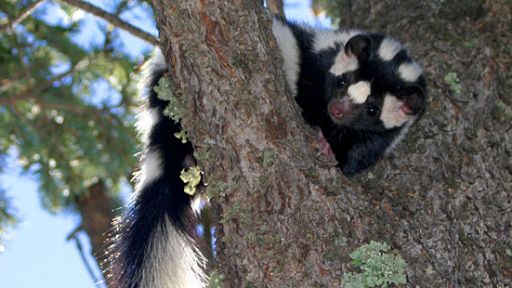TRANSCRIPT
[ominous music] - [Narrator] The jungle.
Mysterious.
Dangerous.
Home to half of all life on earth.
For centuries, scientists have tried to understand this place, and yet they still know next to nothing about it.
[animals chittering] Now, a new breed of explorer is on the trail of the jungle's most deeply held secrets.
[dramatic music] We're about to follow these 21st century pioneers into a brand new age of discovery.
They come equipped with an arsenal of high tech tools that can reveal a jungle we've never seen before.
- Whoa!
[dramatic music] - Oh wow!
[men cheering] - [Narrator] This is the next generation of jungle exploration.
- Never thought I'd live to see that.
- [Narrator] This is Deep Jungle.
- [Announcer] This program is made possible by contributions to your PBS station from viewers like you.
Thank you.
[ominous music] [animals chittering] - [Narrator] The mission to understand the jungle is only just beginning.
The rainforest is the most complex place on earth.
But in Borneo, a professor from Alaska Pacific University is scaling it with biology, mathematics, and a convergence of ancient and cutting edge technology.
Roman Dial's day at the office is like no other.
His destination is the top of the tallest jungle trees in the world.
- Unlike most of the other canopy scientists who seem to be studying the canopy one tree at a time, I am more interested in the whole forest.
- [Narrator] Other researchers need to climb down between each tree, but thanks to a cross-bow, Roman doesn't have to.
- Oh I got it, I can't believe it, I snagged it so now I'm just gonna get this fishing line and reel in the lynch cord and then we'll be able to set up the rope and get to the next tree.
- [Narrator] This clever technique means he can move from tree to tree, staying up for days at a time.
His extreme methods are set to transform our understanding of the jungle world.
Roman is realizing a dream, to become a canopy creature.
Compared with most of the creatures here, his ability to get around the canopy is still pretty limited.
But there are some distant relatives, who seem to encourage his modest achievements.
- These orangutans have been studied, oh look a gift, thank you.
Oh now you want something in return?
One of the best places to see orangutans moving through the forest up close.
[bright music] - [Narrator] The subject of Roman's study is not the wildlife but the trees themselves, after all, they create the complex architecture of the place.
Step one is to make a map of this new world.
And with space age technology, it's a map like no other on Earth.
A laser beam, and a GPS linked to a computer, measures the volume of the jungle's trees and plots the spaces between them.
The technique turns complex vegetation into simple blocks, the result of all this, the first ever 3D-jungle map.
This incredible map can help us interpret the structure of the jungle, and compare the shapes and volumes of different forests.
Roman's data gives us new ideas about how the jungle's physical makeup shapes the very life within it.
This computer realization can take us on a virtual tour through the canopy.
But there are those who are starting to do it for real.
For canopy expert Nalini Nadkarni, this is a jungle first, it's her maiden voyage on a new kind of jungle craft.
Nalini has spent two decades climbing to the top of the rainforest, living suspended for days in a single tree, now she can sweep across the canopy's entire surface.
- You can see canyons and valleys suddenly you realize that it's completely three-dimensional.
[epic music] - [Narrator] Research by people like Roman and Narlini has revealed that 10 times more species live here than we once thought inhabited the entire planet.
30 million species of animals may live in the canopy alone.
A single tree can hold more species of ant than are found in the whole of the UK.
[bright music] [animals chittering] Rainforest wraps around just 6% of the earth's land mass, and yet it contains more than half of all living things.
[bright music] [animals chittering] - Wow!
This is incredible.
Look at this.
It's a mistletoe.
Yikes!
Look at that, it's so great, it's beautiful.
That's incredible.
[bright music] [animals chittering] - [Narrator] But it's easy to get carried away by the latest technology.
We know next to nothing about the creatures that are hidden behind the mass of leaves.
Most of the jungle still remains a dark and mysterious place.
Here, tracking down even a large animal can be like searching for a needle in a green haystack.
However, some of the jungle's animals are so elusive and so exciting that they stand out like a Holy Grail.
And people will go to the ends of the earth to find them.
[bright music] [animals chittering] On the island of Sumatra there's a giant predator whose behavior has never been observed in the wild.
It's the Sumatran tiger.
This brief, blurry shot is the only moving image of one ever recorded in the wild.
These two men believe they have the technology, and the forest know-how, to film the tiger once and for all.
Jeremy Holden has been studying the tigers here for over 10 years.
But in all that time, he has never had more than a brief glimpse of one.
He's guiding wildlife cameraman, Gavin Thurston, deep into the forest.
Gavin brings with him remote infrared cameras that may help him succeed where all others have failed.
[dramatic music] Tigers once roamed throughout Sumatra.
Now an inaccessible corner of Kerinci Seblat National Park is one of their last strongholds.
Protected by a thick barrier of plant and insect life, this is one of the remotest locations on the planet.
Today, only about 500 Sumatran tigers survive in the wild.
To find and film just one of them will be a huge publicity coup for the conservation of this endangered animal.
- Quite probably this is the biggest challenge of my career, I mean nobody has ever successfully filmed tigers in the wild here.
So it could actually be the highlight of my career if I get a shot or alternatively it could be the end of my career, if I don't.
Joking apart, you do feel bloomin' nervous out here.
I don't think I'll be going anywhere much on my own, I'll always be hanging on to Uncle Jeremy!
- [Narrator] Just getting to the tiger's habitat will be half the battle.
Day one involves crossing the same river seven times.
[ominous music] [water rushing] The only animals Gavin has come close to so far, are several hundred leeches.
- Have I?
Oh yeah there's one there.
Did you put that there?
This is a leech and he's got about 10 million friends.
And every time you walk down the path they latch straight onto your trousers or boots and then find a way to get to your skin.
They're quite sweet really, aren't they?
- [Narrator] Base camp is two days walk from the nearest track.
When you're this far from civilization, talk turns to what dangers may lurk outside.
- The main dangers here are certainly elephant.
- Really?
- Yeah, if you see a tiger it'll run away, if you see an elephant it's going to chase you.
I've only met them once in the forest.
And we had to literally run for our lives.
- What about snakes things like King Cobra 'cause that's quite an aggressive snake isn't it?
- Yes, there's King Cobra, there's Red headed Krait, there's Sumatran Spitting Cobra.
- Ok. - So all the deadly snakes are here, I've seen all of them here as well.
- Perfect.
- Trodden on almost most of them, but the King Cobra.
Six meters long, if you get bitten by it you'd have to write a note to your wife and kids and that would be it, there's no way we could get you out in time.
- All right then.
Great.
So on that note then, good night then, no.
- [Narrator] It's not just large and venomous animals that can disturb your sleep here, there are unique parasitic moths, like something out of a horror story.
[man laughing] - This is not what you want to read before you go to bed, is it?
- [Narrator] Moths drinking tears from the eye of the author who photographed himself.
The attack occurred in the night, the moths proboscis sucks from the outer part of the lid where there is an overflow of tears, due to irritation, that's a great thought just before you're about to go to sleep, isn't it?
[ominous music] [animals chittering] - [Narrator] Like so many jungle explorers before him, Gavin is willing to suffer just about anything to achieve his jungle dream.
Somewhere out there stalks the elusive tiger.
[gentle music] Gavin isn't the only pioneer trying for a jungle first.
Off the East coast of Africa, on the Island of Madagascar one man is hunting for another infamous rainforest creature.
Phil deVries has come from the University of New Orleans in search of an animal that is legendary in the annals of jungle exploration.
This is certainly a good place to look for extraordinary creations.
90% of the creatures here are found nowhere else in the world.
[bright music] [animals chittering] - What do you think of that?
You want that?
You got it.
I have always wanted to do that.
- [Narrator] But chameleons are not what Phil is looking for.
He specializes in insect biodiversity, and here in Madagascar lives a giant moth so bizarre that at first no one even believed it could exist.
But if Phil is to have any hope of seeing the moth, then first he must find a very special flower.
[bright music] [animals chittering] In Madagascar Phil is following in the footsteps of the first jungle explorers.
- Somewhere, I'll find you.
- [Narrator] He has spent most of his life in this kind of rainforest adventure.
But the story of this quest goes back 150 years.
It all began back in 1862, in this small office in the south of England.
It was here that Charles Darwin first examined an unusual flower that had everyone baffled.
An orchid from Madagascar that seemed to defy the laws of nature.
This flower hid its nectar at the bottom of a long narrow tube.
It seemed inconceivable that any insect could ever reach it.
But, Darwin famously predicted that somewhere in Madagascar there must be a gigantic moth with a tongue 12 inches long.
Darwin's peers ridiculed him for his prediction.
But, 150 years later, Phil has re-discovered the famous Comet orchid high in a tree and now he hopes to show that Darwin was right after all.
- This is what Darwin was all excited about, look at the size of that nectary.
The moth has to have a proboscis that long to insert into there the beginning of the flower, the opening, down this tremendously long nectar spur just to get the reward.
Which is right at the bottom of that.
The question is, will the strange flower act as bait to attract the world's most remarkable moth?
Up in the tree, he rigs an infrared camera.
If the moth appears it will be in the dead of night.
But Phil's camera can film in total darkness using infrared light invisible to the moths.
There are no guarantees, only 10% of Madagascar's original rainforest remains.
This jungle is so disturbed that from one year to the next, no one can be sure that the moth still exists.
After dark the flower acts like a beacon, releasing a trail of scent through the forest.
Hawk moths can pick up smells from long distances.
But even so, it's a small flower, and it's a jungle out there.
The infrared light is turned on.
The flower in the tree, and Phil on the ground, are bathed in a light visible only to our cameras.
Now all he has to do is wait, and wait, it's going to be a long night.
[animals chittering] In Sumatra, Gavin and Jeremy don't have the luxury of a flower to bait their quarry.
Somehow they have to predict where a Sumatran tiger is likely to be.
- This is possible for tiger coming along here.
No tiger is going to walk through that, no tiger is going to walk through that.
The team will set up six different motion sensitive cameras.
Each will be triggered to record when any animal trips an infrared beam.
- Okay, that's it.
- [Narrator] The placement of the cameras is critical.
They are primed to operate for weeks at a time.
And will record anything that moves, day or night.
[bright music] [animals chittering] Each camera has a range of about 30 feet.
The trouble is, a single tiger's territory is about half the size of New York City.
Little wonder the shy tiger has never been filmed before.
- Well that one's fine.
- Gavin's quest is one of the most ambitious projects ever attempted with this kind of technology.
But high-tech equipment is increasingly being used by jungle researchers to open new windows on hidden worlds.
And some of the most startling results are being gathered in the dead of night.
In Panama, scientists are using imaging systems that cut through the darkness to reveal the secret world of the jungle's bats.
Here, 72 species of bat divide up the forest into different niches.
Each lives in a different way.
Each feeds on a different prey.
[dramatic music] There are bats that eat fruit, bats that drink nectar, others that hunt every kind of insect.
But as always, the jungle supports much more.
There are killer bats here too.
[dramatic music] Some are built for fishing.
There's another kind that eats frogs.
And even one that hunts lizards.
Not even the mice are safe from the nocturnal hoards.
This is what the jungle is all about, countless species all sharing the same three dimensional world in superbly specialized ways.
But life in the jungle isn't just about incredible diversity.
It's also about huge numbers.
In Congo, another bat spectacle is about to be revealed, this time, by heat-sensitive cameras.
[ominous music] [animals chittering] Thermal imaging shows animals hidden amongst the jungle foliage.
The warm body of a fruit bat shines out from the cooler vegetation.
And these bats are on the move.
For the first time we can witness a night-time migration of staggering proportions.
Literally millions of bats are flowing out of the jungle to feeding grounds in the North of Zambia.
[ominous music] At dawn the full extent of the spectacle is revealed, the greatest gathering of fruit bats anywhere in the world.
8 million bats hang from the branches of one square mile of forest.
Their collective weight has been known to break the branches of a tree.
The phenomenon only lasts a matter of weeks, and then suddenly the bats are gone.
Disappearing once more into the depths of the forest.
Keeping track of a single animal as it travels through the jungle is an almost impossible task.
Even the largest of them is famous for its ability to appear for a moment, and then melt back into the dense tangle of leaves.
The one thing we do know about forest elephants is that there are hundreds of thousands of them in the jungles of Central Africa.
But we have very little idea of what they do in the forest, or where they go.
Most of what little we do know comes from a time when hunters were guided by Bayaka pygmies to gather ivory by the boatload.
Today, Bayaka trackers still lead people into the forest hunting for elephants.
- The small one I've already seen it, it's like a young male again, so he's just going to have a look and see if he can see other tracks.
- [Narrator] Steve Blake is a biologist from the Wildlife Conservation Society.
If he can get near enough he may finally solve the mystery of where these jungle giants go.
Getting close without being charged depends on the past hunting experience of a tracker named Mambelume.
- Mambelume has probably killed between 100 and 200 elephants in his life, I should think.
So he's got incredible experience of how they react when they're hurt, how they react when they're aggressive, how they react when they're frightened and so he's just invaluable aside from his tracking skills.
- [Narrator] Mambelume no longer hunts elephants for food.
And these men bring tranquilizer darts, not bullets.
Darting an elephant has been done before on the Savannah, but getting close to elephants in this thick forest is extremely dangerous.
Mike Kock, the team vet, knows just how dangerous.
- Elephants specialize in not only trying to spike you with their tusks, but they also use their very large body size to press down on you so they'll use the front of the trunk and the forehead to try and squash you.
I mean, there's been many instances where elephants have basically squashed people so you can hardly find them.
- [Narrator] They get lucky, an adult female enters the small clearing.
- These three elephants know something's going on.
They've sort of spotted us but now they're not sure quite what's happening.
The vet is trying to advance to get into a position to take a shot, we've just frozen because even though we're exposed and in the open, elephants have got very bad eyesight and as long as you remain still, it's hard for them to see you.
- [Narrator] He must fire the dart into her hind flank.
But with the animal head on, he can't get a clear shot.
- [Narrator] This is the most dangerous moment of all.
If she catches his scent, she may very well charge.
[ominous music] - So now we want to give her another half a minute to relax, I think Mike may well have her in sight.
Mike, Mike.
- Normally we would have expected her to go down by now, we're in six minutes and she's still standing, but the great thing is we can see her, she's very calm, and I suspect because she didn't get nervous, her blood isn't really pumping and it's taken her a little while longer to go down.
But this is fine, she doesn't know what's going on, she's probably drunk, and hopefully she's going to fall over very soon.
- [Narrator] The drugged elephant is down, but now there's a complication, a young male is standing guard.
The men decide he is small enough to be driven off.
[men shouting] - Mike, how's she looking have we got plenty of time?
- Yeah, we've got plenty of time.
- Good.
- [Narrator] This is what their expedition is all about, a pioneering project to place tracking collars on the elusive forest elephant.
But the WCS team needs to work fast.
They want to keep the elephant sedated for as short a time as possible.
An antidote to the tranquilizer will bring the elephant around.
It's time to beat a hasty retreat.
[ominous music] The collar acts like a mobile phone attached to a GPS.
Twice a day it will beam the elephant's location via satellite to the world wide web.
The animal's journey will be plotted on the internet every day for 2 years.
The mystery of where the elephants go in the forests of the Congo will soon be revealed.
[insects chirping] Back in Madagascar, Phil is still waiting for his jungle first.
- I gotta move this leg, it's dying.
- [Narrator] And he's is starting to doubt if the moth will ever appear.
In Sumatra they've had better luck, they've found tiger tracks.
- What we've got here is a real clear, clear pug here, this is the front foot.
What's often the case is when you set these cameras is the tigers are curious so they follow exactly the path you've taken the day before to see exactly what you're about.
Fantastic, this is a territorial scrape here, you can see a beautiful clear print here, she's dug her foot in, scraped it back.
Straight through she's following exactly the trail we were on yesterday.
- [Narrator] Gavin knows Sumatran tigers can be man-eaters, and suddenly, stalking a deadly predator doesn't seem such a good idea.
- Is there any chance she could still be around then?
- Maybe, who knows.
- We're alright just walking up on her like that then, we've got no chance of her getting a bit, I dunno, territorial with us then.
- No, no if she hears us coming she'll be long gone.
- This could be it.
- [Narrator] The motion sensor's beam has been broken, but have they captured the tiger on tape?
- Whatever's passed has passed at 2:23.
So there's maybe a 10 second delay.
- The water's moving.
- It's definitely come through here because this is the only track it can possibly take.
It's not on there.
- Is that the end then?
- That's it that's two minutes.
- I think what's happened is probably the delay between the animal coming through the sensor and reaching the camera, it's too long.
- [Narrator] The tiger has outfoxed them.
The technology has let them down.
Phil is becoming equally disillusioned.
But eight hours into his stake-out, 142 years 7 months and 5 days after Darwin's prediction, all his efforts are about to pay off.
- There it is.
It's hovering in front of the orchid, the tongue's coming out.
Amazing, look at that.
[dramatic music] There it goes, it's trying to find the opening, there it goes, it's in.
It's drinking.
Yahoo!
Unbelievable, but we did not get it pulling the pollinary out.
- Where did it come in?
- It came in right here.
- Was it's tongue unfurled or folded?
- There's tons of that.
And it pushed itself down in and then once it did that, I'll bet you anything is that once the vasidium, the sticky pit of the pollinium, there it is!
Unbelievable!
The moth is back.
[dramatic music] Unreal, look at that.
- [Narrator] Darwin dared to predict such a bizarre creation could evolve in the jungle.
- Never thought I would live to see that.
- [Narrator] And it's required a combination of modern technology, and a lot of old fashioned patience, to finally reveal the creature in action.
So what is it about the jungle that drives such extreme evolution?
The structure of the place traps a constant layer of heat and moisture.
Nutrients and energy are trapped into a cycle that fuels a creation explosion.
And a variety of life that is found nowhere else.
One of the most dramatic demonstrations of this diversity can be found in the jungle's bird life.
The forest is so full of fruit that males are free to concentrate all their efforts on wooing their females.
These displays take many forms, but when it comes to the courtship dance there is a small orange bird in New Guinea that is at the top of its tree.
The King Bird of Paradise does just about everything possible to impress a mate.
[upbeat music] In Latin America, Kim Bostwick believes she has discovered a contender for the king bird's crown, it's the Manikin.
Most jungle researchers can't get near their subjects, but Kim's birds are positively jumping to be noticed.
- They don't mind me being here and they kind of show off, that's what their whole life is about is showing off what they can do so that the female can be impressed and also mate with them.
Right there we just heard a male doing a little bit of a courtship display.
- [Narrator] The displays of these Manakins are so fast that there's no way the human eye can see what they are doing.
But with high speed imaging, the secret of their dance can finally be cracked.
- This little baby was the break through for my research, it's a high speed video camera that enables me to record at 500 frames a second.
Your average camera goes at 30 frames a second, which means your missing 90% of what's happening.
So with this camera I'm able to capture these behaviors and play them back in slow motion and just look and see what they're doing.
The big mystery is how these birds make their peculiar high-pitched calls.
The images from the high speed camera show clearly that the sounds come not from the bird's mouth but from its wing tips.
At 80 hits a second, this is quicker than the speed of a hummingbird's wing, a movement so fast it is invisible to the human eye.
And there's more.
The dance of the red-capped manakin has another surprise in store.
Kim's knowledge of the bird's ritual is now so intimate, she knows every move.
- So first thing you do, you're sitting on your perch and click you fly away.
Once you're out there you come swooping in, do a loop-de-loop in the air, land on the perch and at the end of that, what the males do, is that they lean over, lift up their tail, quiver the tail slightly and nail their feathers against their sides.
And now you're going to do a moon walk and this is the only known case of birds moonwalking to my knowledge.
But they basically, do these little steps backwards and it looks like a Michael Jackson slide, it's very nice.
[upbeat music] - [Narrator] If Michael Jackson's moon-walk can be found in the jungles of Central America, then who knows what we might find next?
With the right technology, more and more jungle secrets are being revealed, and today's jungle explorers are starting to produce real results.
The tagged elephant has traveled over 40 miles in just a few days.
A pattern of their jungle wanderings begins to emerge.
Jungle elephants are traveling further than anyone ever imagined.
They're migrating huge distances through the forest, and across park and country borders alike.
Favorite destinations are fruiting trees that may be imprinted on their memories from youth.
And they also converge on unusual clearings in the heart of the forest.
It turns out the elephants create these mysterious openings mining them for minerals.
And they gather here in huge numbers.
Elephants are forest engineers.
They actively shape the jungle, driving paths through the forest and distributing seeds in their dung along corridors that stretch for hundreds of miles.
One of the most profound discoveries of this study is the extent to which these elephants are changing the structure of the jungle.
If the animals can shape the jungle, Roman Dial's research is showing that the opposite is also true, the jungle can also change the shape of the animals within.
Here in Asia, the canopy creatures have abilities not seen anywhere else.
Roman's computer map shows why this might be.
- The open spaces here are much more, much much bigger almost by an order of magnitude, than they are in the New World Tropics.
In Borneo you push through this layer into this really big open zone up high so this is really a unique place.
- [Narrator] Roman is comparing this forest to other jungles he's mapped.
Elsewhere, the trees are tightly packed together but in Borneo the structure of the forest is different.
[dramatic music] Here the blocks of vegetation are much further apart.
There is simply more space between the trees.
Roman's measurements reveal how a difference in the spacing can change the environment completely, and that means the animals change too.
- If you look behind me here you can see that the forest is really open.
This openness of the forest is unique to the rainforests of Borneo in South East Asia.
And it's this open space that changes things for the animals that makes gliding perhaps the best way to move through the rain forest.
Oh yeah, this is what I'm talking about.
This is a Draco, it's the famous flying lizard of Borneo.
This is a male he has a throat fan but what's much more interesting is his ribs on the side of his body extend out almost as long as his body is to form wings.
We're about a hundred feet up.
Oh, there he goes.
[bright music] This is the only place in the world you're going to see lizards fly.
Its incredible.
[bright music] - [Narrator] Roman's work shows how a change in the structure of the forest can drive the creation of new species, flying lizards, frogs, squirrels, even flying snakes.
Most evolved here and nowhere else.
Scientists think that we've only discovered 5% of the animals that live here.
It is a new image of abundance and vitality, but it hides a stark truth, many jungle creatures are threatened with extinction.
1200 miles away, Gavin and Jeremy are on the trail of one of the most vulnerable, the Sumatran tiger.
- We've followed this tiger's tracks now for about a kilometer and a half, about 20 minutes and she's still going, she's headed up this slope.
Jeremy tells me that once she's on this path there's no turn off at all so she's definitely going to go past the camera trap.
So the only thing is, I'm really excited but I'm trying not to build my hopes up after what happened last time with the camera failing, I'm not sure I could bear to see that again.
The tracks have gone straight through it, I tell you if she hasn't, if she isn't on that tape, I don't know what I'll do.
- This is it, the moment of truth.
What do you reckon?
Yes?
No?
I tell you, I don't normally get excited but I am quite excited about this.
- So this has been knocked, that's not the composition you had, is it?
It's not looking down the track, is it?
- No, it was, yay!
Oh my God.
- It's going to come right in, this is where we sprayed the piss.
- Oh my God.
- Really, you don't realize how lucky you are to get this.
We can watch it on the laptop.
- Thank you, thank you, well we'll go and check the other trap.
- Yes!
Oh my God, that's beautiful, she was there for ages.
There's that bat again catching oh whoa, two of them, first ever recorded behavior of bats catching flies around a tiger.
- Thank you.
- Thank you, makes it even more worthwhile when you get the shot.
[triumphant music] [animals chittering] - [Narrator] Filmed with infrared night vision, the elusive Sumatran tiger emerges from the shadows.
It is the first clear record of this animal in its wild jungle habitat.
It is hard to believe that a giant predator like this could have remained hidden for so long.
But this tiger's home is the most complex place on Earth, and secrets hide easily here.
Deep in these green forests, modern day adventurers are taking us to places that we've never been before.
It takes perseverance and dedication to unravel the mysteries of such an inhospitable place.
With the help of space age technology a whole new frontier is opening up right here on Earth.
- [Announcer] This program was made possible by contributions to your PBS station from viewers like you.
Thank you.
- [Narrator] Everybody gets a sweet tooth now and then.
And in the jungle, honey is the cure.
The Bayaka satisfy a craving by breaking a bee hive for its honey.
The first step is dealing with the bees.
Smoke causes the bees to turn their attention from protecting their hive to protecting themselves.
Once the smoke enters the hive, the bees are immediately diverted to eat as much honey as possible, as they may have to abandon the hive at a moment's notice.
The Bayaka use this valuable time to take some of the sweet honey for themselves.
Once the smoke clears, the bees return to the hive and start where they left off before the smoke, making honey.
[people chattering] The last step?
Share the wealth, it's a treat for everyone to enjoy.
[insects chittering] [bright music]

